You searched for:"Marcelo Zugaib"
We found (76) results for your search.Summary
Rev Bras Ginecol Obstet. 1998;20(6):350-356
DOI 10.1590/S0100-72031998000600008
Objective: to evaluate the uterine cervix by digital and transvaginal ultrasound examinations in pregnant women at high risk of having premature delivery. Methods: during the period between February 1995 and September 1997, 38 pregnant women at high risk of having premature delivery between the 20th and 36th week of gestation were examined. These patients were submitted weekly to both digital and transvaginal ultrasound examinations. The digital examination evaluated the uterine cervix using two parameters: length and dilation. The transvaginal ultrasound studied the length and the anteroposterior diameter of the uterine cervix. The behavior of these cervical measurements was analyzed throughout the pregnancies. The two methods were compared regarding cervical evaluation and accuracy of premature birth diagnosis. Results: the rate of premature deliveries was 18.4% (7/38). Digital examination resulted in cervical evaluations with variation coefficients of 30.3% for length and 193% for dilation. Transvaginal ultrasound resulted in cervical evaluations with variation coefficients of 14.7% and 26.5% for the anteroposterior diameter and length, respectively. The cervical length measures obtained on ultrasound were always greater than those obtained on digital examination. Through analysis with the hypothesis test, an indirect relationship was observed between the cervical length and the gestational period for digital examination and ultrasound study (p<0.05 and p<0.01, respectively), and a direct relationship between the cervical dilation and the gestational age observed on the digital examination (p<0.01). Conclusions: among the parameters studied by means of the digital and transvaginal ultrasound examinations, the ultrasound cervical length presented the best accuracy in the diagnosis of premature birth, proving to be more reliable for the evaluation of cervical alterations in pregnant women at high risk of premature delivery.
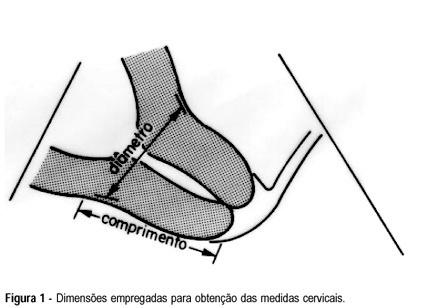
Summary
Rev Bras Ginecol Obstet. 2007;29(7):352-357
DOI 10.1590/S0100-72032007000700005
PURPOSE: to analyze the pattern of fetal breathing movements (FBM) in diabetic pregnant women in the third trimester of pregnancy. METHODS: sixteen pregestational diabetic and 16 nondiabetic (control group) pregnant subjects were included fulfilling the following criteria: singleton, between 36-40 weeks of gestation, absence of other maternal diseases and absence of fetal anomalies. The fetal biophysical profile (FBP) was performed to evaluate the following parameters: fetal heart rate, FBM, fetal body movements, fetal tone and amniotic fluid index. The FBM was evaluated for 30 minutes, period when the examination was integrally recorded in VHS video for posterior analysis of the number of FBM episodes, the duration of each episode and the fetal breathing movements index (BMI). The BMI was calculated by the formula: (interval of time with FBM/total time of observation) x 100. At the beginning and in the end of the FBP maternal glucose levels were checked. The results were analyzed by the Mann-Whitney U-test and the Fisher exact test, adopting a level of significance of 5%. RESULTS: the glucose levels demonstrated significantly superior average in the diabetic group (113.3±35.3 g/dL) in relation to the normal group (78.2±14.8 g/dL, p<0.001). The average of the amniotic fluid index was higher in the group of the diabetic cases (15.5±6.4 cm) when compared with controls (10.6±2.0 cm; p=0.01). The average of the number of FBM episodes was superior in the diabetic ones (22.6±4.4) in relation to controls (14.8±2.3; p<0.0001). The average of the BMI in the diabetic patients (54.6±14.8%) was significantly higher than that in the control group (30.5±7.4%, p<0.0001). CONCLUSIONS: the elevated blood glucose levels can be associated with a different pattern in the FBM of diabetic mothers. The use of this parameter of the FBP, in the obstetric practice, must be considered with concern in diabetic pregnancies.
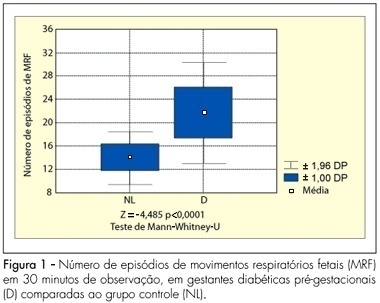
Summary
Rev Bras Ginecol Obstet. 2000;22(6):353-363
DOI 10.1590/S0100-72032000000600006
Purpose: to study the prognostic parameters for perinatal death in pregnancies with absent or reversed end-diastolic flow velocity on umbilical artery dopplervelocimetry. Methods: two hundred and four pregnancies were retrospectively reviewed. The methods used were cardiotocography, fetal biophysical profile, amniotic fluid index and dopplervelocimetry of ductus venosus, fetal aorta, middle cerebral artery, umbilical arteries and uterine artery. The logistic regression model was applied to one hundred and seventy cases in order to determine the most accurate variable for predicting perinatal death. Results: the mortality rates were: 28 cases of intrauterine fetal death (13.7%) and 45 neonatal deaths (22.1%). A statistically significant correlation was found between death and the studied variables. The perinatal death rate in the group with birth weight below 1,000 g was 74.7%, and in the group with gestational age at delivery below 31 weeks it was 66.3%. By logistic regression, birth weight was the most accurate variable for predicting perinatal death, and a probability curve for death according to this variable was obtained. Conclusions: absent or reversed end-diastolic flow velocity in the umbilical arteries is a severe fetal condition, where the risk of perinatal death is mainly related to birth weight and a gestational age at delivery below 31 weeks.
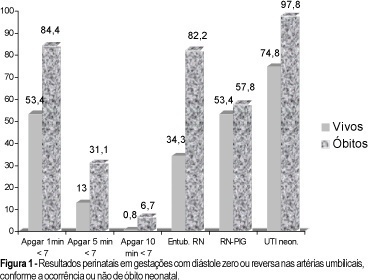
Summary
Rev Bras Ginecol Obstet. 2002;24(6):377-381
DOI 10.1590/S0100-72032002000600004
Purpose: to establish a reference range for cervical length measurement throughout gestation in twin pregnancies and to correlate cervical length with gestational age at delivery. Methods: retrospective analysis of prospectively collected data between 1994 and 2000, involving 149 twin pregnancies undergoing transvaginal ultrasound examination every four weeks for measurement of cervical length. Results: one hundred and twenty-seven women (85.2%) delivered after 34 weeks, 20 (13.4%) between 24 and 33 weeks and two pregnancies resulted in fetal loss before 24 weeks. The mean gestational age at delivery was 36.3 weeks. A total of 497 ultrasound examinations with cervical length measurement were performed in 127 patients with twin pregnancies who delivered after 34 weeks (mean = 4 examinations per patient). All scans were carried out between 9 and 39 weeks (mean = 29.4 weeks). There was an inverse correlation between cervical length measurement and gestational age at the scan in twin pregnancies (r=-0.44; p < 0.0001). The mean value was 44 mm at 10 weeks and 28 mm at 36 weeks. The corresponding fifth percentile values of these gestations were 28 mm and 12 mm, respectively. Cervical length measurement changes were more pronounced in the second half of the pregnancy (Kruskal-Wallis test, p=0.0006). Mean cervical length measurement and 90% prediction interval values were established throughout gestation by regression analysis. Twenty-six cases delivered before 34 weeks, nine of these cases (34.6%) had at least one cervical length measurement below the 5th percentile. Conclusions: cervical length shortens gradually throughout gestation in twin pregnancies but changes are more significant in the second half of the pregnancy. Approximately one-third of the pregnancies that delivered before 34 weeks had at least one cervical length measurement below the 5th percentile for the gestational age.
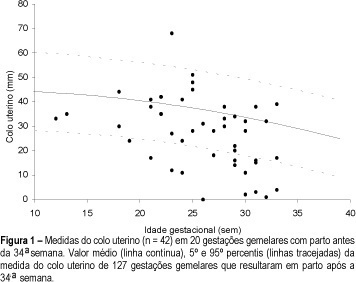
Summary
Rev Bras Ginecol Obstet. 2004;26(5):383-389
DOI 10.1590/S0100-72032004000500007
OBJECTIVE: to evaluate the measurement of uterine height in order to predict fetal growth restriction (FGR), according to a local curve. METHODS: from July 2000 to February 2003, 238 high-risk pregnant women were submitted to uterine height measurements between the 20th and the 42nd week of gestation. The gestational age of all the women was well known, confirmed by early ultrasound. Fifty (21%) women gave birth to infants considered small for their gestational age. The measures were performed by a single observer, who took 1617 uterine height measurements, from the upper border of the symphysis pubis to the fundus uteri, using tape measurement. The diagnosis of FGR was confirmed after birth according to the Ramos's curve. The women were divided into two groups according to their infant's birth weight and the data were statistically analyzed by the Fisher's exact test or Kruskal-Wallis's test. The sensitivity (SE), specificity (SP), positive predictive value (PPV), and negative predictive value (NPV) were calculated. The test for two proportions with normal approximation was performed to analyze the continuous variables. RESULTS: one measurement below the 10th percentile, according to gestational age, resulted in SE = 78.0%, SP = 77.1%, PPV = 47.6%, and NPV = 88.8% for the identification of FGR. If one measurement was below the 5th percentile, the SE, SP, PPV, and NPV were 64.0, 89.9, 62.7 and 90.4%, respectively. CONCLUSIONS: one measurement below the 10th percentile for the gestational age, according to the local curve, proved to be a good predictor of FGR.
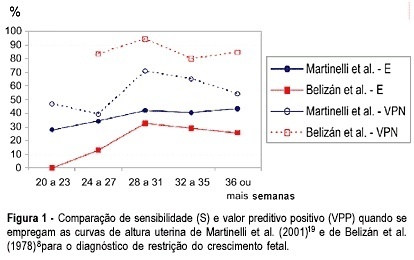
Summary
Rev Bras Ginecol Obstet. 2013;35(9):394-400
DOI 10.1590/S0100-72032013000900003
PURPOSE: To investigate the usefulness of the measurement of cervical length and of the test for phosphorylated insulin-like growth factor binding protein-1 (phIGFBP-1) performed sequentially in the prediction of preterm birth and the correlation between tests. METHODS: We analyzed data from 101 asymptomatic pregnant women with a history of premature delivery. The ultrasound measurement of cervical length and phIGFBP-1 test were performed in parallel every three weeks, between 24 and 34 week. The best cutoff value for each cervical evaluation was established by the ROC curve, and the two tests were compared using nonparametric tests. We determined the sensitivity, specificity and predictive values of each test and of the association of the exams for the occurrence of delivery before the 37th weeks. RESULTS: There were 25 preterm births (24.8%). The cervix length showed the highest sensitivity and was able to predict preterm birth in all evaluations, with similar accuracy at different gestational ages. The test for phIGFBP-1 was not helpful at 24 weeks, but was able to predict prematurity when performed at 27, 30 and 33 weeks. The combination of tests increased the sensitivity (81.8%) and negative predictive value (93.7%) when compared to the separate use of each test. The mean cervical length was lower in women with a positive test. CONCLUSIONS: Both cervical length and the test for phIGFBP-1 were able to predict premature delivery, and sequential combination of both tests showed a high sensitivity and high negative predictive value.
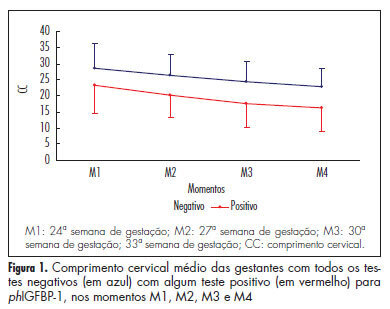
Summary
Rev Bras Ginecol Obstet. 2002;24(6):401-406
DOI 10.1590/S0100-72032002000600007
Purpose: to evaluate, in the high-risk pregnancies with oligohydramnios, the assessment tools for fetal well-being and perinatal results. Methods: five hundred seventy-two high-risk pregnancies were retrospectively analyzed. All of them presented with oligohydramnios established by AFI <=5.0 cm. Severe oligohydramnios was detected in 220 cases (AFI<=3,0 cm). The fetal well-being tests included: antepartum cardiotocography, biophysical profile score (BPS) and dopplervelocimetry of umbilical and middle cerebral arteries. Multiple gestation, fetal anomalies and premature rupture of membrane cases were excluded. Results: severe oligohydramnios was significantlly associated with abnormal and suspected cardiotocography results (23.2%), abnormal biophysical profile score (10.5%), abnormal results of middle cerebral artery dopplervelocimetry (54.5%), small for gestational age infants (32.7%) and meconial amniotic fluid (27.9%) when compared to pregnancies with AFI between 3.1 and 5.0 cm. This group presented: abnormal or suspected cardiotocography results (13.9%), abnormal biophysical profile score (4.3%), abnormal results of middle cerebral artery dopplervelocimetry (33.9%), small for gestational age infants (21.0%) and meconial amniotic fluid (16.8%). Conclusion: the oligohydramnios severity in high-risk pregnancies allows to discriminate the cases that are related to adverse perinatal outcome.
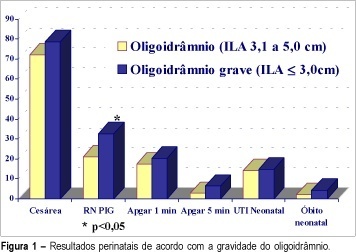
Summary
Rev Bras Ginecol Obstet. 2010;32(8):405-411
DOI 10.1590/S0100-72032010000800008
PURPOSE: the aim of this study was to describe perinatal and maternal outcomes of pregnancies complicated by sickle cell disease (SCD), comparing to pregnancies of women with sickle cell trait (SCT). METHODS: this was a retrospective cohort study, covering the period from March 2001 to April 2008, which included all pregnant women with SCD (n=42) followed up at a university hospital in the Southeast region of Brazil. The maternal and perinatal outcomes were compared to those of pregnant women with SCT (n=56) who were followed up at the same service. RESULTS:SCD-SS was diagnosed in 42 (82.4%) pregnant women and SC in 9 (17.6%). Mean (±SD) maternal age was significantly lower in the SCD group (26.0 years) compared to SCT women (28.7±7.1 years; p=0.018). The following maternal complications were more common among women with SCD in comparison to SCT: urinary tract infection (25.5 versus 8.9%; p=0.04), pneumonia (23.5 versus 1.8%; p=0.002), pulmonary hypertension (15.7 versus 0%; p=0.002), and blood transfusion during delivery or postpartum (33.3 versus 5.4%; p=0.001). Adverse perinatal outcome was more frequent in the SCD group compared to the SCT group: prematurity (49 versus 25%, p=0.01); mean gestational age at delivery (35.2 versus 37.9 weeks, p<0.001); fetal distress (56.9 versus 28.6%, p=0.006); birth weight <2,500 g (62.7 versus 17.9%, p<0.001); mean birth weight (2,183 versus 2,923 g, p<0.001), and small for gestational age infants (29.4 versus 10.7%, p=0.029). Two maternal deaths (3.9%) occurred in the group with SCD. CONCLUSION: Pregnant women with SCD are at greater risk for maternal morbidity and for adverse perinatal outcomes than women with SCT.